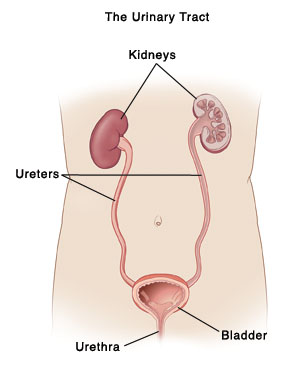When Your Child Needs a Voiding Cystourethrogram (VCUG)
Voiding cystourethrogram (VCUG) is a test that uses X-rays to show the flow of urine through the urinary tract. It allows the healthcare provider to see how your child’s bladder functions. It also shows if urine is flowing backward into the kidneys or if another urinary problem is present.
 |
| VCUG tests the flow of urine as it moves through your child’s urinary tract. |
Before the test
-
Explain what is happening in an age-appropriate manner. Tell your child who the people are they will be seeing and why the test is being done.
-
Help your child change into a hospital gown.
-
Remove your child’s jewelry and glasses if they are worn.
-
Tell your child’s healthcare provider and the technician giving the test if your child is allergic to medicine or the contrast used for the test.
-
Tell the provider about any conditions or illnesses your child has had recently.
During the test
-
The test lasts about 30 minutes. You may be allowed to be with your child during the test.
-
For the test, your child lies on their back on an X-ray table. If your child is an infant or toddler, they may be wrapped in a blanket or another restraint to keep them still during the test.
-
Several X-rays are taken. The X-rays may be seen on a video screen.
-
The genital area is cleaned with an antiseptic.
-
A thin, flexible tube called a catheter is then gently put into the urethra. The urethra is the tube that carries urine out of the body. This may cause some mild pain for a moment. The catheter is then slowly passed into the bladder.
-
A special dye called contrast is put into the catheter to fill the bladder. The contrast makes the bladder show up clearly on the X-ray.
-
More X-rays are taken while the bladder is filled with contrast.
-
The catheter is removed and your child is asked to urinate. More X-rays are taken as the bladder empties.
After the test
-
Your child can get back to normal activities after the test.
-
If your child was given contrast, it will pass naturally within a day.
-
Have your child drink lots of water to help the dye pass out of the body.
-
Sometimes children will complain of having trouble or pain with urination after the test. Or you may see a small amount of blood in the urine. This is due to irritation from the tube that was placed in your child's urethra. If the symptoms are worsening or concerning you at home, call your child's healthcare provider.
Getting your child’s results
Your child’s healthcare provider will discuss the test results with you during a follow-up appointment or over the phone. You can talk about treatment options at this time if needed.
Online Medical Reviewer:
Marc Greenstein MD
Online Medical Reviewer:
Marianne Fraser MSN RN
Online Medical Reviewer:
Raymond Kent Turley BSN MSN RN
Date Last Reviewed:
5/1/2022
© 2000-2024 The StayWell Company, LLC. All rights reserved. This information is not intended as a substitute for professional medical care. Always follow your healthcare professional's instructions.